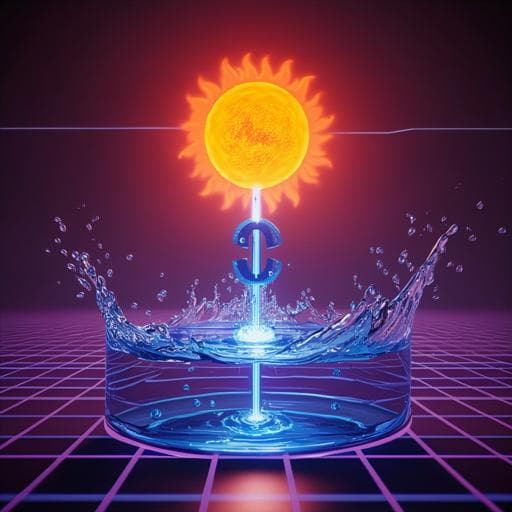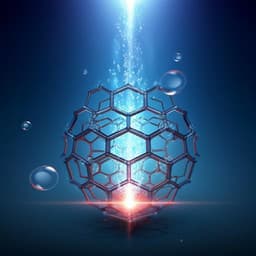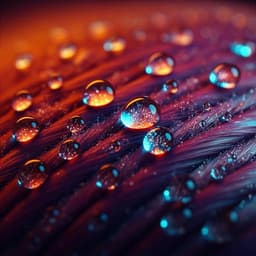
Engineering and Technology
Spontaneous solar water splitting with decoupling of light absorption and electrocatalysis using silicon back-buried junction
H. Fu, P. Varadhan, et al.
Discover the innovative back-buried junction (BBJ) photoelectrochemical (PEC) cell design, achieving over 95% light harvesting, developed by Hui-Chun Fu, Purushothaman Varadhan, Chun-Ho Lin, and Jr-Hau He. This groundbreaking research enables highly efficient solar water splitting with impressive hydrogen generation rates.
~3 min • Beginner • English
Introduction
The study addresses the challenge of achieving efficient, unassisted solar water splitting using silicon photoelectrodes, where conventional designs couple light absorption, surface protection, and electrocatalysis on the same (front) side. This coupling leads to parasitic optical losses from catalyst loading and protection layers, as well as suboptimal charge separation. Moreover, single Si photoelectrodes cannot provide sufficient photovoltage for overall water splitting (typically ~1.7–1.8 V required). The authors hypothesize that spatially and functionally decoupling light harvesting (front surface) from electrocatalysis and carrier collection (back surface) via a back-buried junction (BBJ) design will minimize optical, electrical, and catalytic losses, maximize photocurrent, and—through monolithic series interconnection—enable unassisted water splitting with high solar-to-hydrogen efficiency.
Literature Review
Prior PEC Si photoelectrodes suffer from parasitic light absorption by catalysts and protection layers and from insufficient photovoltage for overall splitting. Partial decoupling using micro/nanostructures with selective catalyst placement has been demonstrated (e.g., high-aspect-ratio Si micropillars/microwires with Ni-Mo catalysts), but complexity and integration challenges remain. Tandem absorbers can deliver sufficient voltage but face lattice/thermal mismatch and fabrication complexity when combined with Si. Interdigitated back-contact (IBC) and back-buried junction concepts from photovoltaics have achieved record efficiencies, suggesting potential benefits if adapted to PEC. The literature also reports pH-dependent performance, temperature and angle-of-incidence effects on PEC behavior, and the need for protective oxides (e.g., ALD TiO2) to mitigate corrosion. These works motivate a design that decouples optical and catalytic interfaces, optimizes carrier collection, and enables series connection without front-side shadowing.
Methodology
- Device design: A silicon back-buried junction (BBJ) PEC cell using n-type c-Si (165 ± 40 μm) with front-side micropyramidal texturing for broadband, omnidirectional light harvesting. A 40 nm thermally grown SiO2 passivation layer and 60 nm SiNx antireflection coating were applied to both front and back surfaces.
- Junction engineering: On the back (catalysis) surface, local ion implantation created interdigitated p+-Si emitter (hole collection bars ~400 μm wide) and n+-Si back-surface-field (BSF; electron collection bars ~200–250 μm wide), forming lateral p-n junction arrays. A shallow front-surface field (FSF) via light P implantation over the micropyramids reflected minority carriers away from the textured front surface to reduce recombination.
- Metallization and catalysts: Interdigitated back metal grids aligned to the doped regions were deposited (up to ~70% area coverage) serving both as carrier collectors and back reflectors. Pt was sputtered on n+ regions (HER catalyst) and Ni on p+ regions (OER catalyst). For series modules, cells were connected laterally via tin-soldered Al foil (p+ to n+ between adjacent cells) to form 3S-BBJ strings.
- Packaging: Devices were sandwiched between quartz sheets and sealed with waterproof epoxy, leaving only catalyst areas exposed. For stability tests, ALD TiO2 (approx. 120–140 nm) was deposited on contact pads prior to 5 nm Pt. In some tests, a Pt-sputtered (5 nm)/Ti foil (0.01–0.1 mm) was attached to the electron collection bar using Ga-In eutectic to enhance protection and current distribution.
- Characterization: Photovoltaic J-V in air under AM 1.5G. PEC measurements used standard three-electrode (half-cell) and two-electrode (wireless) configurations under simulated AM 1.5G. Electrolytes: 1 M H2SO4 (pH ~0), 1 M Na2SO4 (pH ~7), 1 M KOH (pH ~14). LSV measured vs RHE (or Pt in two-electrode). IPCE (300–1100 nm), EQE/IQE/APCE, and optical absorptance/reflectance/transmittance measured in air and in electrolyte. Temperature (293–323 K) and angle-of-incidence (−90° to 90°) dependencies were recorded.
- Current loss analysis: Total current loss separated into optical (reflection JS and transmission JT) and internal (Jint = electrical JE + catalytic JC) components. JS and JT calculated by integrating reflectance and transmittance with the AM 1.5G spectrum; Jint derived from the difference between absorptance in electrolyte and IPCE; JC obtained from the difference between IQE and APCE; JE = Jint − JC.
- Unassisted operation: Three BBJ cells connected in series (3S-BBJ) operated in a two-electrode setup (3S-BBJ photocathode with dark Pt anode) under 1 M H2SO4 and under Red Sea water outdoors at noon. Gas evolution quantified by gas chromatography (GC-TCD) and by integrating chronoamperometric charge; Faradaic efficiency assessed from correlation.
Key Findings
- Optical performance: Front-side light harvesting exceeded 95% absorptance from 300–1100 nm due to micropyramidal texturing and SiNx AR coating, with back metal grids functioning as reflectors.
- Photovoltaic metrics (unit BBJ cell in air, AM 1.5G): JSC = 40.98 mA cm−2, VOC = 0.62 V, FF = 74.46%, efficiency = 18.92%.
- Half-cell PEC performance (unit BBJ):
- HER: Saturation current density J_H+/H2 = 40.51 mA cm−2 at E0(H+/H2), best at pH ~0; strong performance across pH 0, 7, 14.
- OER: J_O2/H2O = 28.68 mA cm−2 at E0(O2/H2O), with non-ideal onset features attributed to Ni oxidation.
- Temperature and AOI robustness (HER):
- With temperature increase (293–323 K), J_H+/H2 slightly increased (bandgap shrinkage) while VOC − E decreased.
- AOI tolerance: <14% degradation in J_H+/H2 over −30° to 30°; <8% degradation in VOC − E across −90° to 90°.
- Current loss analysis for HER at pH 0 (unit BBJ):
- Optical loss Jopt = JS + JT = 5.44 + 0.67 = 6.11 mA cm−2.
- Internal loss Jint = 3.43 mA cm−2, comprising JE = 1.76 mA cm−2 (electrical) and JC = 1.67 mA cm−2 (catalytic).
- Series-connected module (3S-BBJ):
- In air (PV): VOC ≈ 1.83 V.
- Unassisted HER in 1 M H2SO4: Current density = 12.60 mA cm−2, yielding STH = 15.62% at Vapp = 0.
- Hydrogen generation rate: 240 μg cm−2 h−1 (abstract) and ~80 μg cm−2 in 20 min confirmed by GC-TCD; Faradaic efficiency >90% for initial 15 min.
- Outdoor operation with Red Sea water (~pH 8.1) at noon: Current density ≈ 9.14 mA cm−2; STH = 11.33%.
- Stability:
- With ALD TiOx (~120–140 nm) + 5 nm Pt, unassisted operation stable for ~40 h before corrosion due to cracking/etching of protective layers under high current density (~280–300 mA through ~1 cm2 interface).
- With added Pt/Ti foil protection on the electron collection bar, initial unassisted J_H+/H2 ≈ 10.5 mA cm−2 (STH ~13%) and <10% current drop over 100 h, indicating markedly improved durability.
Discussion
The BBJ architecture decouples light absorption (front) from electrocatalysis and charge collection (back), directly addressing the primary bottlenecks of Si-based PEC systems: front-side catalyst and protection layer shadowing, surface recombination on textured absorbers, and insufficient photovoltage for overall splitting. By relocating junctions and catalysts to the back surface with interdigitated p+ and n+ regions and extensive back mirrors/contacts, the device achieves near-maximal solar absorption and short carrier transport paths, reducing both optical and electrical losses. Quantitative loss analysis confirms minimal reflection/transmission losses and low internal losses, validating the design rationale. Furthermore, lateral series interconnection of three BBJ cells enables photovoltages (~1.83 V) adequate for bias-free water splitting, delivering state-of-the-art STH efficiency (15.62%) for Si-based unassisted PEC and robust performance across pH, temperature, and angle-of-incidence. The approach demonstrates that spatial and functional decoupling is a powerful strategy for optimizing the multiple, often competing requirements in PEC devices, bringing practical solar-to-hydrogen production closer to reality.
Conclusion
This work introduces a silicon back-buried junction (BBJ) PEC architecture that spatially decouples light harvesting from electrocatalysis, enabling independent optimization of optical management, carrier separation/transport, and surface catalysis. The unit BBJ cell achieves >95% absorption and a HER current density of 40.51 mA cm−2 with minimal optical (6.11 mA cm−2), electrical (1.76 mA cm−2), and catalytic (1.67 mA cm−2) losses. Monolithic lateral series interconnection of three BBJ cells produces an open-circuit voltage of ~1.83 V and supports unassisted water splitting with 12.60 mA cm−2 current density and 15.62% STH efficiency, with demonstrated operation in real seawater conditions. Future research should focus on further enhancing long-term durability under high current densities via more robust, crack-resistant protective layers and optimized current distribution (e.g., improved catalyst coverage or flow fields), reducing noble metal usage while maintaining high activity, and scaling the BBJ-PEC architecture to larger modules with efficient series/parallel integration.
Limitations
- Long-term stability: Although ALD TiOx protection extended operation to ~40 h, protective layers developed cracks under high current densities (≈280–300 mA total), leading to corrosion. Additional protection (Pt/Ti foil) improved stability to 100 h with <10% degradation but introduced added components and potential complexity.
- Catalyst/material choices: Use of Pt (HER) and Ni (OER) may impact cost or long-term durability; Ni oxidation contributed to non-ideal OER onset behavior.
- Measurement scope: Many metrics are half-cell measurements; unassisted tests used a dark Pt anode and specific electrolytes. Faradaic efficiency was quantified primarily during the initial period (e.g., >90% for first 15 min) and not over the entire long-term operation.
- Interface current distribution: Limited exposed catalyst area and high localized current density at the electrolyte interface can accelerate degradation, indicating a need for optimized electrode geometries and current spreading.
- Environmental variability: While AOI and temperature tolerance were characterized, broader outdoor, long-duration field testing across varying conditions was not reported.
Related Publications
Explore these studies to deepen your understanding of the subject.







